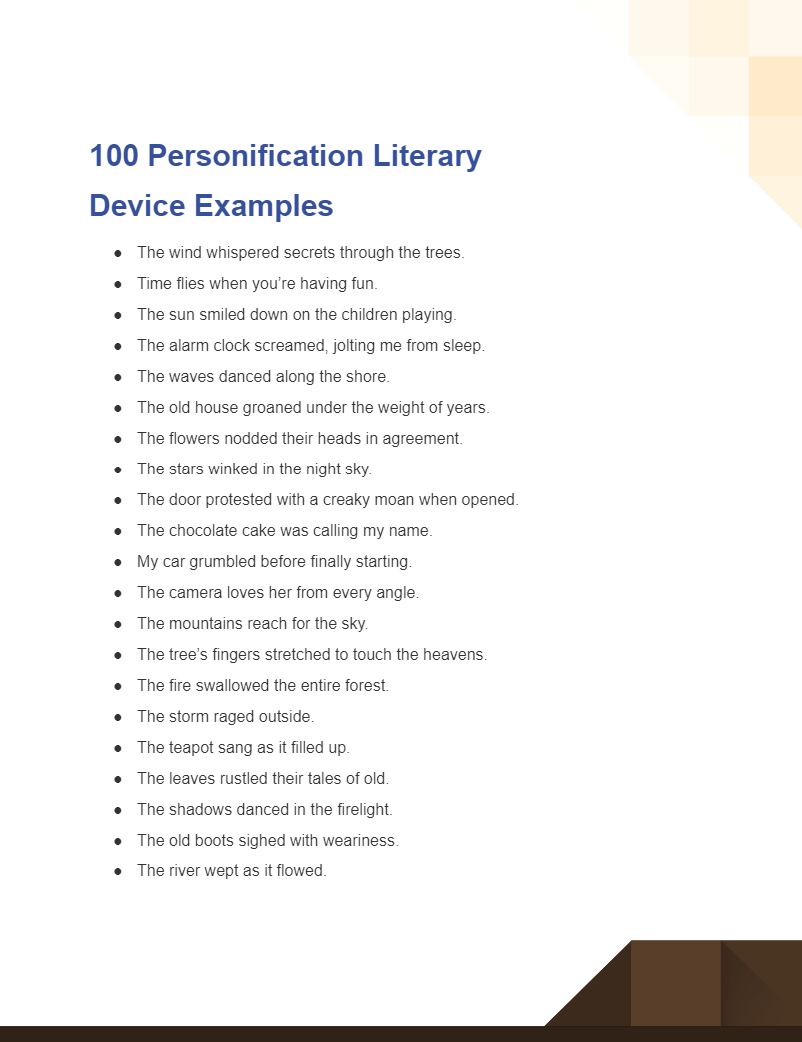Personification Literary Device
In the vast realm of literary techniques, personification stands as a sentinel, inviting readers to envision a world where inanimate objects and abstract notions come alive. Through this age-old device, writers bestow human characteristics upon the non-human, weaving a tapestry of emotions and vivid imagery. Dive deep into the universe of personification, uncovering its illustrious personification examples, the art of crafting it, and the nuanced tips that transform prose into poetic brilliance.
What is Personification Literary Device? – Definition
Personification is a literary device wherein non-human objects, animals, or abstract concepts are given human attributes or emotions. It serves to create more relatable scenarios, induce empathy, or simply paint a vivid picture in a reader’s mind. By attributing human characteristics to these entities, writers can convey complex emotions, create strong imagery, and breathe life into otherwise inanimate elements of a story or poem.
What is the Best Example of a Personification Literary Device?
One of the most iconic examples of personification is in William Wordsworth’s poem “I Wandered Lonely as a Cloud,” where the daffodils are described as “dancing” in the breeze. The poet doesn’t merely describe the flowers’ movement; he gives them the joyous, human-like quality of dancing. This portrayal enriches the scene, encapsulating the poet’s sense of awe and the flowers’ liveliness, making the moment more poignant and memorable.
100 Personification Literary Device Examples

Personification, an evocative literary device, bestows human traits upon the inanimate, rendering vivid imagery and depth. This tool creates a bridge, connecting readers to abstract concepts or objects, enriching narratives with human essence and relatable emotions.
- The wind whispered secrets through the trees.
- Time flies when you’re having fun.
- The sun smiled down on the children playing.
- The alarm clock screamed, jolting me from sleep.
- The waves danced along the shore.
- The old house groaned under the weight of years.
- The flowers nodded their heads in agreement.
- The stars winked in the night sky.
- The door protested with a creaky moan when opened.
- The chocolate cake was calling my name.
- My car grumbled before finally starting.
- The camera loves her every angle.
- The mountains reach for the sky.
- The tree’s fingers stretched to touch the heavens.
- The fire swallowed the entire forest.
- The storm raged outside.
- The teapot sang as it filled up.
- The leaves rustled their tales of old.
- The shadows danced in the firelight.
- The old boots sighed with weariness.
- The river wept as it flowed.
- Fear gripped the village.
- The kettle whistled its impatience.
- The book contains a world, waiting to be discovered.
- The wind howled in anger.
- The fog crept silently into the town.
- The moon guarded the night.
- The pen poured out stories of adventure.
- The curtains whispered secrets of the past.
- The clock’s hands raced each other.
- The night sang lullabies of starry dreams.
- The city never sleeps.
- The old bridge groaned under the pressure.
- The rain kissed the parched earth.
- The blizzard’s fingers numbed everything they touched.
- The window pane’s tears reflected its sadness.
- The rocks stood as ancient watchers.
- The forest held mysteries of old.
- The fire spat sparks angrily.
- The guitar cried a melancholic tune.
- The thunder spoke of the storm’s fury.
- The fields danced with golden wheat.
- The roses blushed at the gardener’s praise.
- The clouds lazed around in the blue.
- The volcano’s anger spewed over the village.
- The ocean whispered tales of distant lands.
- The car’s heart roared to life.
- The snow blanketed the world in silence.
- The flowers reached thirstily for the morning dew.
- The ruins echoed with memories.
- The world turned its back on the fading star.
- The computer hums with potential.
- The bells sang out the hour.
- The castle’s walls held stories of battles long gone.
- The old chair sighed under its burden.
- The staircase creaked tales of the past.
- The hurricane’s eyes saw devastation.
- The mailbox waited eagerly for letters.
- The radio buzzed with tiny voices.
- The grapevines intertwined in a lover’s embrace.
- The path meanders through life’s adventures.
- The night sky cloaked the earth in mystery.
- The keys chuckled at the typist’s mistakes.
- The apple beckoned from the tree.
- The stairs complained under the weight.
- The ruins whispered of a glorious past.
- The ship sailed on, brave and resolute.
- The lamp watched over the room.
- The moonlight tiptoed through the window.
- The blanket enveloped me in warmth.
- The breeze played with her hair.
- The map charted adventures untold.
- The motorway’s stretch yearned for travelers.
- The tower reached for eternity.
- The desert held secrets in its sands.
- The attic’s dust whispered of bygone days.
- The island dreamt of visitors.
- The pages held treasures of words.
- The lighthouse stood as a beacon of hope.
- The pebbles murmured underfoot.
- The notebook held my deepest secrets.
- The engine roared with anticipation.
- The painting captured the sun’s very soul.
- The piano sighed with memories.
- The meadow dreamed under a summer’s day.
- The coffee aromas beckoned the sleepy traveler.
- The road traveled on, weaving stories.
- The barn guarded its old secrets.
- The old clock remembered many moments.
- The mirror reflected a world unknown.
- The shoes remembered every journey.
- The mountains whispered old legends.
- The pot bubbled with excitement.
- The radio relayed tales from distant lands.
- The suitcase held memories from a lifetime.
- The river’s song spoke of distant mountains.
- The sky painted a canvas of wonders.
- The walls bore witness to history.
- The wind sang lullabies to the meadow.
- The old diary hid tales of adventure.
What is personification used for?
Personification is a literary tool where human qualities are attributed to non-human entities, ideas, or objects. This technique is employed for several reasons:
- Enhanced Imagery: By assigning human traits to non-human entities, writers can paint a more vivid picture, making abstract or unfamiliar concepts easier to understand.
- Emotional Connection: Assigning human emotions or actions to an object or idea can evoke a deeper emotional response from the reader. It makes the abstract tangible and relatable.
- Bring Objects to Life: Through personification, inanimate objects or natural elements become active participants in a story or poem, often furthering the narrative or contributing to the theme.
- Elevate Language and Tone: Personification can elevate the language of a piece, giving it a more poetic or sophisticated feel.
Why do writers use personification?
- Engagement: Personification can capture readers’ attention by presenting the world in a new or unexpected way.
- Relatability: Humans are naturally inclined to understand and interpret the world through their own experiences and emotions. By giving human characteristics to non-human entities, authors bridge the gap between the familiar and the unfamiliar.
- Symbolism: Often, personified elements can symbolize larger ideas or themes. For instance, a raging storm can represent turmoil or conflict.
- Emphasis: By personifying a particular element, authors can emphasize its importance or role in the narrative.
- Conveying Complex Ideas: Difficult or abstract concepts can become clearer and more approachable when personified.
How do you Write Personification Literary Devices?
- Identify the Purpose: Before using personification, determine why you’re using it. Do you want to evoke a certain emotion, clarify a concept, or add depth to a scene?
- Choose the Right Subject: Not all objects or concepts will benefit from personification. Some naturally lend themselves to this literary device more than others.
- Be Consistent: Once you’ve decided to give an object a certain human quality, be consistent with it throughout your narrative.
- Avoid Overuse: While personification can be powerful, using it too frequently can dilute its impact.
- Stay Relevant: Ensure that the human trait you’re assigning to an object or concept is relevant and adds value to your narrative.
Tips to Using Personification as Literary Device
- Practice Observation: Think about how objects around you might move, sound, or react if they had human qualities.
- Read Widely: To understand how personification is effectively employed, read diverse literature. Note how different writers use this device and to what effect.
- Avoid Clichés: Phrases like “time flies” or “the wind whispered” are commonly used. While they are valid examples of personification, try to invent fresh comparisons.
- Be Precise: The more specific and vivid your description, the more impactful your personification will be.
- Revise and Refine: Writing is a process. After using personification, revisit your work to see if it fits or if another literary device might be more effective.
By understanding and mastering the use of personification, writers can bring depth, emotion, and clarity to their narratives, engaging readers in profound ways.


